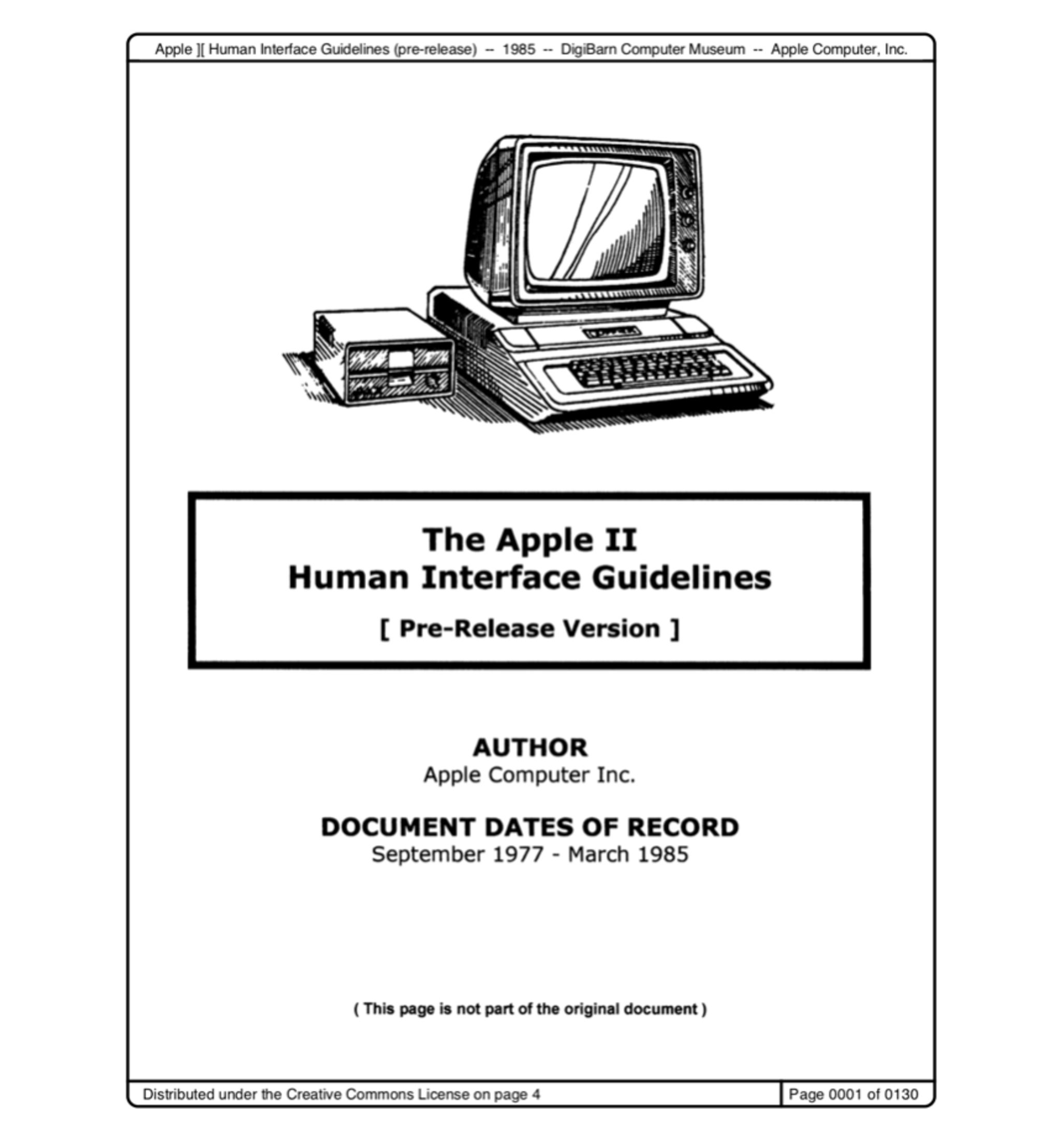Genuine question.
I know they were the scrappy startup doing different cool things. But, what are the most major innovative things that they introduced, improved or just implemented that either revolutionized, improved or spurred change?
I am aware of the possibility of both fanboys and haters just duking it out below. But there’s always that one guy who has a fkn well-formatted paragraph of gold. I await that guy.
The graphical user interface.
They don’t invent it (xerox PARC did), but Apple correctly identified that the user experience of existing computer systems was holding it back from being a thing everyone owns, and made computers a bad fit for many types of work that seem extremely obvious now (digital media creation particularly)
They did this more or less again with the smartphone: business folks and super nerds were the smartphone market before Apple. Now it’s the average person’s computer.
The graphical user interface.
A million times this. Not only did they popularize the ideas, but MacOS’s UI design was so ahead of its time that it’s barely changed since then. It was by far the most polished operating system at the time. Old Apple actually was innovating while the market was kind of stagnant.

This screenshot was in 2007. The competition was Windows Vista. It’s a night and day difference. I had this version of the iMac at the time and was super impressed, even if I did switch back to Windows a couple of years later. Looking back at it, it still looks quite “modern”.
Just to piggy back on this comment, OSX was released before 9/11 and windows XP, so Microsoft was still selling Windows ME at the time! Aside from the desktop backgrounds looked very similar.
I feel old.
Time to schedule your colonoscopy gramps
I’ve got an '08 iMac with this version of MacOS, El Capitan I believe. Going from that to my 2019 M1 MBP running Sonoma is really no different. Sure there’s features missing but I can still sync my notes and the few other Apple things I actually use between the two.
Plus my iPods can still sync with both devices, they just moved iPod into Finder in the new versions.
Well, KDE3 could look cool too.
I’ll admit, back then I really wanted a Mac.
Just after trying to use them a few times I know that behavior is more important than appearance on screenshots. Also such looks exhaust you emotionally.
Wrong wrong wrong. Macontoshs gui was crap and buggy as hell. Every seasoned it expert knew it was a shit lousy interface designed to dupe people into believing it was secure when in fact it proliferated viruses and security holes, and drove the control of computing into an avaricious humanity destroying company culture known as apple. DO NOT EVER PROMOTE THE GUI AS GOOD. ITS CRAP.
buggy as hell
No it wasn’t
viruses and security holes
That has nothing to do with GUI
No it wasn’t
OSX 10.0 in general actually was. Jobs offered 10.1 for free as an apology, and it fixed a lot of things.
and i think in general, their attempt to really focus on user experience first always seemed to define their business… trying to make things that people would WANT to use was what made Jobs and Apple stand out… other brands were better known for performance, for example…
Exactly. They innovated
- a GUI that people wanted to use and ushered in a new era of computer guys
- several times a personal computer it laptop that people wanted to use and set new standards for others to follow
- personal music devices that worked so well they set the standard.
- a phone that just works and set many standards for other phones to follow
- an App Store that set standards for usability and security, and set a high bar for others to follow
- a mobile payment system that’s secure and private, and set a standard for the industry to follow
- shared resources and config across devices and family members, setting new standards for usability and convenience
I could probably go on for a while. The thing is that everything in tech is an iteration: almost nothing is completely new. Apple has consistently applied design and usability to revolutionize many different areas of tech. It is true innovation with real change and huge impact
The iPod wasn’t very special. Lots of competitors in that space.
Their phone wasn’t very special. It lacked a lot of features like enterprise email for 1-2 years. It was also slow and locked to a slow carrier in the US for that time.
They managed to sell it though. Their ads and marketing is always been great even if the devices weren’t.
Jobs really wanted to make tech usable for the mainstream. Just look at the first iPod all the other MP3 players at the time were for the geeks and music nerds. They were clunky, had ugly geek esthetics and the software was hard to use for most people. And the non techies had no idea where to get mp3s. The iPod together with the iTunes Store really sold the MP3 player to the masses.
Wrong wrong wrong. It was never about ease of use. It was always about taking control away from the user, and hiding authority for control. This kind of deceptive practice has led to what we gave today - cars selling subscription hearing seats. The truth is, the gui was always buggy and a product unfit for its purpose from day one. Apple sold it as a means to get consumers to accept a defective product from the start, perpetuating their ability to always sell updates, forcing consumers to pay for things THEY DO NOT NEED.
Wrong wrong wrong. The graphical user interface is crap and will always be crap. The whole matter of popularity is marketing bunkum. Console command interface was al ways faster and better than any gui for general computing tasks. The gui is fine for office tasks, but shit for everything else. The popularity of the gui today has driven a massive upscale of cruddy bloated virus infected software. The fact that most people now only know gui has meant that control of viruses has slipped away. Had console commands been the mainstay for computing, viruses and security holes would never have been allowed to proliferate as they do today.
Bud, you sound like a technophile geek. The kind of person who custom built his own computer. You’re not the target customer. Apple builds products for people that don’t care about technology, they just care about what the technology does and want it to be easy and seamless. And that is a vast majority of the people.
I built my own computer but as a working laptop there is nothing close to a decked out MacBook Pro. Yes, I’m aware of the price, but my company paid it, and it was a good choice from every angle.
Bingo. Apple builds appliances.
Let me guess, you use arch?
If this guy isn’t rolling his own distro he’s basically a scrub like the rest of us.
The first virus was made in 1986 for IBM personal computers. Nothing is free from computer viruses. Not macOS, not iOS, not Android, not GNU/Linux, not freeBSD, not even an IBM PC from the 80s. All software can be exploited. The only reason GUI software is the most exploited is because it is what people use. https://en.wikipedia.org/wiki/Brain_(computer_virus)
GUI is not only intended for office tasks. In fact, I would argue that many office tasks are better suited for command line, but I’ll agree that nobody knows how to do that anymore.
GUI was always best suited for artists. Apple has, for a long time, especially since OSX, been explicit about catering to artists. Can you imagine editing video in a terminal? Or editing a layered image? Or producing music?
While you may be correct I think you’re still missing the point. CLI is for super nerds. While you and I may know how to use it, the average person doesn’t, and is unlikely to put in the effort to learn. That is the innovation that Apple made in bringing computing to the mainstream. It was precisely because people didn’t have to learn how to navigate the CLI environment and instead got an easy point-and-click interface that computers caught on with the public at large, and that gained Apple an absolute ton of cash money and noteriety.
Awww… I’m a supernerd? Thank yoooooou ❤️ ❤️ ❤️
I always considered myself to be kind of an average run-of-the-mill nerd.
The document-centric model of desktop applications largely originates from the early Mac. How do you open a document in a desktop OS? You double-click on the document, and the OS finds the correct application to open it with. That was a Mac thing. On most other systems of the mid-1980s, you run your application program (from the command line) and then tell the program to load a file.
Applications as “bundles” of code and data was a Mac thing too, starting with the resource/code division in the classic Mac System. Rather than an application coming with a mess of directories of libraries and data files, it’s all bundled up into a single application file that can contain structured data (“resources”) for the GUI elements. On a classic Mac, you could load an application program up in ResEdit and modify the menus, add keyboard shortcuts, and so on, without recompiling anything.
The Apple Newton had data persistence of a sort that we now expect on cloud applications like Google Docs. Rather than “saving” and “loading” files, every change was automatically committed to storage. If you turn the device off (or it runs out of battery power), you don’t lose your work.
Other systems did have double-click, and app bundles (which I still think are just fantastic) were a NeXT thing. (which of course became Apple, but they weren’t at the time). But yeah, Apple way refined and brought those to a mass market.
app bundles (which I still think are just fantastic) were a NeXT thing.
App bundles were just a better implementation of resource forks, which were invented by Apple and pre-dated NeXT.
(which of course became Apple, but they weren’t at the time)
NeXT was founded by people who worked at Apple (not just Steve) and they were largely put in charge when they came back to Apple. I wouldn’t call them separate companies. Just a weird moment in the history of the company. A lot like what just happened at OpenAI.
App bundles have virtually no relationship with resource forks. I guess you could say that App Bundles COULD include SOME metadata that you could have included in Forks, including the idea that something was an application or not. But that’s about it.
On the NeXT always being Apple thing - I mean, some of it maybe was spiritually Apple, and eventually it was 100% Apple. But we’re splitting hairs.
Polish.
It useless to be first if that product isn’t reliable, sustainable, practical. Apple adds polish to other concepts to make them usable by the vast majority of people.
Laptops existed……with weird keyboard layouts and mice that were afterthoughts. PowerBook pioneered the keyboard forward design that every laptop now has.
Smartphones existed……incredibly limited, weird UI, awkward input, targeted at businesses instead of regular people. iPhone changed everything so much that every other design died.
Collecting different innovations and figuring how to combine them in a way that is practical and sellable is their continuous innovation.
Agreed. They didn’t really “innovate” anything. They stole ideas from other people, and just marketed it better.
I’m sorry but this is kind of horseshit. Apple has legitimately brought some new polish to areas that hadn’t seen them before, but LMFAO at Apple inventing laptops that don’t have weird keyboards.
Apple had great trackpads with multi finger gesture support before anyone else, their keyboards have been nothing special compared to ThinkPads and business grade laptops that sold for the same price as them. Their difference was marketing and convincing consumers to pay business grade prices for consumer laptops.
LMFAO at Apple inventing laptops that don’t have weird keyboards
They weren’t saying the keyboards themselves were particularly good, they were saying Apple’s keyboard placement was a step forward (and it was). This page has a couple of pictures of early laptops - note where the Powerbook keyboard is compared to the others.
The iPhone. It was revolutionary when it came out.
It literally created the modern smartphone market. The Palm Pilots and Blackberries of the day couldn’t compare: the iPhone had a FULL BROWSER. It was insane. The team developing Android saw the iPhone and had a real “holy shit” moment, they had to go back to the drawing board and completely start over in order to compete.
Full browser might be an overstatement. It was still a web full of Flash at that time. And it caused a pretty major limitation on the browser. If there wasn’t an app available, you were often SOL. I do think it sped up the demise of Flash on the web considerably.
I do think it sped up the demise of Flash on the web considerably.
That’s unironically an innovation right there
Nope, there was a lot of Windows Mobile smartphones before iPhones and Androud devices. WiFi, Bluetooth, GPS, phone, thousands of apps, “full browser” (I don’t know what a commenter meant by that, but I could use internet normally)
When iPhone appeared, it was sooo limited. A couple of my regular customers (I was selling qtek/htc smartphones) bought them, but then came back to me: “uhhh, this thing doesn’t allow attachments in emails”, “uhhh, do you have normal maps app for that? can’t drive with that”In what aspect? There were mobile devices with installable applications. And Samsung already had a phone with that form factor.
And who bought them before iPhone came out? There were tablets before the iPad. Nobody bought them either.
A lot of people. If you went with idea they sold previously business oriented devices to regular users, I’d give you that. But it’s not like Apple invented that format or form. I advise everyone watch documentary on Springboard, which was really really ahead of its time. When everyone was messing around with dumb phones, Springboard was working on unified device with camera built-in, connectivity, etc. In fact they were too early with their product, ten years before first iPhone. More to the point, Jobs visited Springboard, said their product was shit, and went on to produce the exact same device with better polish, which was a dick move in my opinion, but that’s business. But saying Apple invented smartphones or refined them. No. It’s an iterative process like everything else.
Apple doesnt create products. Apple creates markets. Nobody bought modern phones before the iPhone. They existed, nobody bought them. Nobody bought tablets before the iPad. They existed, nobody bought them. Nobody bought mp3 players before the iPod. They existed, nobody bought them. Everyone bought them after, and not just from Apple.
Lmao. Apple anti-cpmpetively corners markets by preventing their products from working with anyone who actually innovates anything new.
Here is an alternative Piped link(s):
Piped is a privacy-respecting open-source alternative frontend to YouTube.
I’m open-source; check me out at GitHub.
This is the phone I had as my own and sold to my customers. It came out a year before iPhone among many others. It was a mature product. It was quite shitty in terms of performance, but it had all connectivity and gps stuff, and many apps to work with it all.
Windows’ shitty interface could be improved by cool touch-oriented interfaces (Spb Mobile Shell being one of them), there were 3rd party keyboard apps as well. https://m.gsmarena.com/htc_p3600-1694.php
No wireless. Less space than a Nomad. Lame.
Try and take Tim Cook’s dick out of your throat before typing
Them building a smartphone around a capacitive touchscreen with a software keyboard was the primary innovation of the iPhone.
A full browser that rendered webpages is not an innovation, that’s a result of increased processing power letting them port more browser code over. Pinch to zoom interfacing on a browser might be an innovation, but a web browser on a mobile phone was not innovative, just iterative.
I don’t think I’m going to be that guy, but also not one of the fanboys/haters.
Apple were pretty significant in the development of both FireWire and USB. They were also pretty crucial in driving the adoption of USB with the iMac. Most PC motherboards at the time had a set of jumpers for USB, but you had to buy the actual ports, which took up an expansion slot on the back, and connect them to the motherboard. It was a huge pain in but as the jumpers were censor-specific so had to look at all the specs and buy the right connector. Some aftermarket cases had USB ports on the front/back, but again you had to buy the right connector for your mobo. So everyone kept using serial/PS2/parallel. So peripheral makers weren’t making any devices either. When Apple released the iMac, they got rid of all of those other ports and only had USB. All of a sudden you started seeing USB keyboards, mice, CD/DVD drives, etc…
I might be missing a lot but I feel the iPhone was a complete market segment they created themselves. Android followed a year later.
They also created the tablet market a year or two later.
They also set the trend of earbuds we have nowadays.
Removed headphone jacks.
Removed power adaptors.
There maybe something else that I might have missed.
I remember the first keynote. Jobs kept repeating phrases like music player, web browser, and phone together like that. And then boom, he whipped out the first iPhone that was in his pocket the whole time. While there were similar devices at the time, nothing (to my knowledge) was all one package especially in an all touch device that small.
Yeah, people seem to forget just how groundbreaking the form factor, all the swipe and pinch (and multitouch) interface stuff, having one giant touchscreen, the user friendliness if pretty much everything (versus other phones at the time), etc was. Soon everyone was trying to copy it, which is fine. But saying all they innovated was rounded corners and everything else already existed and was just as good is dumb.
There were a lot of little things that aren’t relevant today but were a big deal at the time. For example it had a web browser that actually worked to view the real internet, even though 99% of webpages were designed for screens the size of 30 iPhones.
Today all webpages are designed to work well on small screens - but that never would have happened without Apple. Or at least it would have taken a lot longer to happen. They got enough people using the internet on a phone to force web developers to support small screens. That was a big achievement - even today it’s a massive amount of work to design a webpage that works well with a mouse and with your thumbs. The tools we have now didn’t exist back then, and before Mobile Safari there weren’t any users of small screens anyway so why would anyone put in all that work?
Phones with web browsers predated the iPhone. They were completely unusable.
giant touchscreen
In the 2007 tech press lull between announcement and launch, there was briefly a made up scandal of accusing Apple of using models with really large hands in promotional photos/videos to make the iPhone look smaller than it was. It’s wild to think about now.
Blackberry did all of that years before Apple. Sure, they didn’t have a touchscreen, but all of the capability was there.
I had a Blackberry Curve and I don’t recall it having a music player. It was also so clunky compared to the iPhone is that it’s almost unfair to say it had the same capabilities. I’m not an Apple fan but I have to grant that their UI was a huge advancement over anything that came before it.
I guess it would be better to say they innovated the slate style phone. Android didn’t come out until 2008 and all other top phones used physical buttons. The iPhone technically only had 5 for general functions.
The LG Prada did that before iPhone too. More accurate to say Apple popularised it and made it a more cohesive package
Haha I had to look it up, but that’s the definition of “innovation”. Literally taking something existing and making it better.
The user interface itself was the innovation. Hell, even Microsoft and Intel had the portable Windows Mobile things. Compared to an iPhone they liked like they were from the Stone Age. I had one and swapping it felt like going to another dimension.
Well, there existed phones that were kind of what smartphones became. Blackberries and Palms get a lot of the attention as they were what executives used, but there were also PocketPC devices that were usually white label manufactured HTC devices that were branded after carriers or some other company like HP. They generally were much larger screened devices with a few buttons at the bottom. They were resistive touchscreens so using your fingers was pretty meh for responsiveness, and the UI was just not designed in a way that was pleasant to navigate. Picture a shrunk down desktop interface. I’d say the UI was the biggest shakeup that they did in the product category, followed by steadily raising the bar for hardware in a space that often would have cheap plastic components. Don’t get me wrong, I think too much glass and aluminum is actually poorer than something like kevlar especially for dents and dings, but it doesn’t look nearly as sexy.
I’d say the UI was the biggest shakeup
I’d say the biggest shakeup was the features Jobs pushed hard in the keynote.
- It was a cellphone. A good cell phone. Everyone had a cell phone and nearly everyone hated them. The blackberry was decent if all you did was send text messages and make phone calls, but it was rubbish at everything else. PocketPC and Symbian and other flip phones were even worse, though each specific model had a different set of feature trade offs (did you ever try writing an email on a small PocketPC device? You had to press tiny keys with an equally tiny stylus and text was almost impossible to read (or alternatively so large that you couldn’t fit enough text. Larger ones were a good experience but they were way too big for most people. Even the iPhone was considered huge at the time (it was much bigger than a blackberry for example).


-
It was an iPod. Everyone (who could afford one) owned an iPod and it sucked having two gadgets in their pocket all day and keeping two gadgets charged. That was the feature that made the iPhone a “must have” product. Combining your phone and music device was a massive improvement and an obvious one even if you weren’t sure about the other stuff. Other phones could play music by then, but they were all still really terrible. I could only fit a single album on my Symbian phone and it took hours of stuffing around and reading manuals and installing buggy software to figure out how to load MP3s onto the device. Yuck.
-
It was able to browse the internet. The real, full internet. Everyone working a desk job was used to doing that all day every day, but now it was possible to do it away from your desk. That was a huge deal and I think by far the most meaningful feature of the iPhone… except it was a product nobody had ever used before, so it couldn’t be the only headline feature.
Ah, that makes sense.
Apple was famous for its innovations in market segments and feature removals.
Maybe modern Apple, but the GUI wouldn’t be where it is today without Apple and specifically Jobs’s Macintosh team, especially those who followed him to NeXT and what they accomplished there then brought with them when Jobs was brought back to Apple.
The first Android was made about 1999/2000, I’d read about it in a trade mag just before I was laid off from one company (they provided that trade mag, which is why I know the date). The idea of running Linux for a phone OS was intriguiging at the tomr, as we were doing some Linux testing ourselves.
At that same time (late 90’s), we were already deploying full-color Palm Pilots with wifi, and eagerly waiting for the integrated phone models whi were projected to be released about 2000.
I was using a Treo with a touch screen before iPhones existed, and I was a late adopter in about 2003 because I don’t do early versions, I wanted CDMA, and didn’t want the Palm-like flip cover thing. The Treo was kind of the first bar-type smart phone, just rounded. I used to watch movies on that thing on flights. I kept multiple SD cards so I could swap them out (they ejected from the top, no opening the case, no power cycle).
I (well, my deployment team) had deployed thousands of Palm Pilots with wifi access, and then Treos, which synced to a desktop app, in the early 2000s, probably 5 years before iPhone existed.
It could send/receive emails, SMS, calendar, load all sorts of apps from simple games like checkers to Monopoly. It did GPS and mapping with a third party SD card.
It had a third party office app that is now available on Android. I used a shopping app that could sync to an account online. It could browse the web (though the web browsing was pretty awful at the time). It could send data wirelessly to people nearby using infrared.
It had a camera (a shitty one) that could also do video. It used a data connection with the cell provider. It had Bluetooth, and could send Palm apps to other devices with it.
There were versions that had Windows Mobile on them, they were pretty good.
I moved to Android from Treo in 2009.
Smartphones weren’t a new idea, Palm had been on it since the mid 90’s, just waiting for the phone tech to be small enough to pack into a Palm Pilot.
Apple never leads, despite what their PR is so good at promulgating.
What they are excellent at is watching the market and timing their entry perfectly, with a product people want, giving the impression that they lead the market. And I don’t say this as a criticism, what they do is brilliant, and the products they release are usually good at what they’re intended to do.
I really like their design at times. The iPhone, from a physicality stand point, is brilliantly balanced, shaped, sized. Unfortunately iOS just doesn’t meet my personal needs.
The first Android was made about 1999/2000, I’d read about it in a trade mag just before I was laid off from one company (they provided that trade mag, which is why I know the date). The idea of running Linux for a phone OS was intriguiging at the tomr, as we were doing some Linux testing ourselves.
Android as a company was created in 2003 with no product at all. They started working on a phone operating system in 2005, were acquired by Google, and then had an early prototype Blackberry knockoff in 2006. The iPhone was announced in 2007 so they abandoned the original plans and started making an iPhone knockoff. The first Android phone was released in 2008.
Smartphones weren’t a new idea, Palm had been on it since the mid 90’s
Apple shipped the Newton in 1993. Well before Palm. And long, long, before shipping the Newton they were talking about hand held computers. The idea that they copied Palm is ridiculous.
Like Palm, the Newton wasn’t good enough to achieve widespread market adoption (and Apple recognised that - killing it in 1998).
Sure - iPhone wasn’t the first pocket computer and it was a very obvious invention that companies all over the world had failed to pull off for decades. I think Microsoft was the closest - their Pocket PC that was pretty good and they had a massive decade long version almost rebuilt from scratch about to ship when the iPhone came out… But Apple beat them to it and Google followed close behind - reportedly Google’s early hardware partners were planning to ship Windows on those devices but Microsoft lost out on the contract negotiations, Satya Nadela said they were just too slow - their hardware partners want to wait for them.
Apple was first to ship a good pocket computer. That was real innovation. Real innovators are the ones that get it right, and being first (to get it right) matters because once it’s done once everyone else can just copy your idea instead of wasting time developing and testing dead end solutions to hard problems. The early Android devices for example, looked more like the old Pocket PC or a Blackberry. They probably weren’t good enough to be successful. They quickly copied ideas like the software keyboard from Apple, and quickly adopted Apple’s open source technology like the WebKit rendering engine.
Target display mode let you plug another computer into your iMac, hit a key sequence, and use your iMac as an external display.
Target disk mode let you hold a key sequence at boot and use your Mac like an external hard disk.
Force Touch is something I am not sure that was ever done outside ~the Mac~ Apple. I still love how the trackpad isn’t really a click, but a haptic tap that can occur at a configurable pressure, and does not occur at all when the device is powered off.
LiDAR in a consumer device was unheard of when it came out with the iPad Pro. At the time it came out, I was working in a lab where we used $160k velodyne LiDAR devices. To have one in a $1k tablet was amazing.
Force Touch was done outside the Mac.
They added it to the iPhone 6S then removed it after iPhone 8.As someone who used to work for Applecare, TDM was a bit of a lifesaver on some calls!
It’s actually been around since the PowerBook — where it was called scsi disk mode.
Apple is one of the companies behind the USB standard. There are other major companies (especially Intel) but they often make really stupid decisions and I don’t think the world would be using USB today if it wasn’t for Apple coming on board and doing some really awesome work. USB-C for example was designed by Apple. And Thunderbolt - another Intel project - was pretty much exclusive to Apple hardware… and it’s rumoured that Apple pushed intel hard to make serious improvements such as using copper instead of fibre optic and including it modern USB standards (thunderbolt, if you don’t know, is basically PCI-E over a USB cable - it works so much better than a regular USB connection the only drawback is it costs slightly more).
They took KHTML, a niche rendering engine that nobody had heard of which didn’t work for major websites… and made it into the foundation that backs every browser except FireFox.
The ARM CPU architecture was technically an independent company, but Apple provided nearly all their funding in the early days, provided ongoing funding for decades before they did anything interesting, and ARM’s founding CEO was an Apple employee.
Most of the best programming languages in the world, especially modern ones but even some old ones that have been re-architected, depend on LLVM which, while it’s an open source project, for many years was exclusively worked on by Apple (who hired the university student that started it as a side project and gave him an unlimited budget to make it what it is today).
They figured out how to make touch screen phones work. It existed before, but it was shit - in particular typing was unusable and while it wasn’t as good on the first iPhone as it is today it was Apple who was the first to find a way to make it “good enough” and that was some seriously innovative stuff. It looks like a tiny keyboard with touch buttons but that is not what’s going on under the hood. It’s far more complex.
Going forward - the Vision Pro headset has some pretty awesome innovations.
I could go on, but you get the picture. A really common theme is they took something that already existed (e.g. the mouse) and figured out how to actually make it good enough for people to adopt it. It takes a lot of R&D to develop something as comprehensive as, for example, the HIG:

Could someone else have achieved those innovations? Sure. If ARM/Apple didn’t do it… I’m sure someone else would have figured out how to make a fast processor that could run all day on a battery small enough to wear on your wrist. But with that and so many other things, Apple’s work was critical (a lot of that was software, not hardware - for example technology like ARC was critical to reach acceptable levels of efficiency). Somebody else would have done it eventually, but I’d argue Apple made it happen decades earlier than it otherwise would have. And once they proved it could be done, others coped them. Which is awesome - as Steve Jobs loved to quote Picasso “good artists copy; great artists steal” and said they do it shamelessly and expect their competitors to do the same… as long as they don’t steal branding. That’s when Apple’s legal team gets fired up - as they did with the early Samsung phones where everything, even the icons on the home screen which could have easily been unique, looked like an iPhone.
USB-C for example was designed by Apple.
They took KHTML, a niche rendering engine that nobody had heard of which didn’t work for major websites… and made it into the foundation that backs every browser except FireFox.
-
KHTML wasn’t so bad. “Major websites” at that time meant less than now. It wasn’t Facebook/Reddit/Google/Twitter time with everything important being on those platforms.
-
They did lots of dick moves to prevent their changes from going back to upstream. I’m not sure taking someone else’s work and then behaving as if that’s a divine blessing is a good thing.
-
Chromium now is really far from Webkit, and of course from KHTML, which died as its own project relatively recently.
-
Everyone absolutely thought the original click wheel iPod, the iPhone and the iPad were all doomed to fail. Hell, the Apple watch didn’t exactly get off to a hot start for that matter.
And back at the beginning, the Mac OS GUI. Yes, Steve Jobs saw the idea of a graphical GUI at Xerox Park, but what his engineers turned out is something completely different. And at the time it was easily as revolutionary as the touchscreen interface of the iPhone.
Actual duds by Apple that I can think of off the top of my head:
- The Cube
- The Mac IIcx
- The Mac IIfx
- Whatever that ungodly massive Unix box was that they branded as Apple
- The liquid cooled G5 cheesgrater
Add to the list of duds:
Apple Pippin - a 5th gen games console. ‘competed’ with PS1, N64 and Sega Saturn. Made the Saturn look like a runaway success by comparison.
Apple Newton - a PDA that sucked balls and was widely mocked.Whatever that ungodly massive Unix box was that they branded as Apple
You might need to be more specific - all Apple computers have been Unix boxes since OSX 10.0
Steve Jobs and a lot of the best people at Apple left the company in 1985. The company was taken over by idiots (“bozos” was Steve’s preferred term).
Steve (and all the people at NeXT) returned to Apple 12 years later. Officially Apple “bought” NeXT but for nearly half a billion dollars but in reality that was clever account keeping to satisfy investors and Apple was in fact on the brink of going bankrupt. They didn’t have half a billion dollars. They didn’t even have enough money to cover salaries of their employees. The people at NeXT took over and made it into what it is today and they refer to 1997 as the year that NeXT bought Apple.
Both the Pippin and the Newton shipped several years after Steve and his core team left. They were products of the “Bozo” management team. Both were killed pretty much at the same time as Steve coming back. He killed a lot of other stupid products as well.
Pippin was just the original Xbox concept before the Xbox arrived. Similar to Microsoft’s windows ce gaming agreement with Sega Dreamcast. Cram a low end computer in a console and put the bootable OS and app on a CD. Boot directly into the game. Same cd could be played on a Mac.
Problem was, it came out at a time when Apple had too many projects going on at once. So it was both too expensive, and left to rot with “licensees” instead of being built, promoted, and sold by Apple.
The original Xbox was a very fragile success; if Halo 1 wasn’t such a god tier system seller, that console would have been dead in the water too.
Microsoft had a VERY hard time convincing developers to get onboard with the console before it launched. I imagine Apple and Bandai had similar issues but no system seller.
Irony — Halo was originally a Mac-only title.
https://kotaku.com/when-halo-was-on-the-mac-and-was-a-totally-different-g-5796019
I had to do some googling, but it looks like it was the Apple Network Server that I’m thinking of.
I have a weird obsession with the cube. It’s such a cool looking computer even by today’s standards. If they didn’t cost a ridiculous amount of money on EBay, I’d buy one just to put on display
If you define innovate as invent something from scratch, then they did not innovate anything. Everything they’ve done has existed prior to them doing it. But under Steve they took those inventions and made them more usable and appealing to the common man.
That’s their strength really. Make stuff easier and more enjoyable to use.
Unfortunately that has led to lock-in in order to hold onto customers. Yes, they give you convenience but you’re bound to their products.
I first realised this when I had an Apple Watch and iPhone 7, then sold my iPhone and got an Android phone and the Watch became useless. Even though I had 3 Mac’s and an iPad Pro, they couldn’t work with Watch. You HAD to have an iPhone.
So I sold the Watch.
Then I paved over MacOS with Linux and I’m happy. Free to use whatever, whenever, however I want to, and added YEARS to the life of my mac’s which both had come to the end of support of MacOS.
My 2015 MacBook Pro and 2012 Mac Mini would be useless now if I was running OSX/MacOS and many apps wouldn’t be supported or even work. New apps definitely wouldn’t be supported because Mac Devs love to drop support for older versions.
On Linux they run great! Fast, fluid, can run any latest app no problem. I think Linux has probably added at least 10 years into the life of these machines.
I had never thought of wiping an old mac and putting Linux on it to give it a new life. That’s a great idea! Thank you.
High resolution displays on laptops, SSDs in laptops.
Those are the two I can think of right now. I believe Linus (LTT) talked about this on WAN show not too long ago aswell.
It’s crazy to think that the original MacBook Air had a spinning hdd, which was 1.8".
It came from the iPods at the time.
It’s crazy to think that the portable, pocket really, music player had HDD.
Modern day planned obsolescence.
Marketing for electronics is definitely a big one, nobody else really has the same cult following, and when somebody like Samsung gets close it feels like whatever the cult version of a knockoff is.
I’d argue that Sony held a cult like following prior to Apple’s resurgence. Walkmen, TVs, Home Stereo and VHS/CD/DVD players would often all ne Sony branded in a number of households.
They also did similar bullshit anit consumer antics like those ridiculous memory stick storage cards that were costly as all hell compared to SD cards.
Sony walked so Apple could run.
Apple is incredibly well polished. It takes ideas that already exists and makes them work for the 90% of people.
It brought the smart phone to the masses. The ipod the iPad. It is the only smart watch manufacturer making profit.
All these existed and most server a function and niche community. Apple bought it polished it and server it up with a user friendly interface.
Can it reinvent the wheel with smart glasses ? This will be it’s biggest test. This is a niche area. This is incredibly expensive and it’s going to be a hard sell.
Ayo fuck TekSyndicate but he did put it quite succinctly:
“Apple are not a technology company. They are a technology recipe company. They take innovations that other companies create and combine them to create compelling products.”
Sorry but that’s bullshit. That would be like disregarding all the engineering that goes into developing a car, just because someone else invented the wheel.
Sure - without that invention they couldn’t exist - but real innovation isn’t just the foundational features of the product. 99% of the work is in small refinements - for example about two hours a day my Mazda is a horrible car to drive because the sun catches the chrome logo on the steering wheel and blinds the driver. The newer models? They have a slightly different shape on the steering wheel that puts the shiny logo in the shade at that time of the day. It takes real work over decades to figure out tiny details like that. Most of the job is things that aren’t obvious when you first have an idea to build a product.
Someone else probably, probably millions of other people, likely had the idea long ago… the real innovator is the one that actually does the hard work to make it a product someone will actually want to use.
99% of the work is in small refinements
Sorry but that’s bullshit. Inventing something takes a lot, a lot, a lot more effort than packaging something. Incremental improvements are much easier (in comparison ) when you’ve got the working prototype already on the market.
And wtf is that analogy? The fanboy in you is really showing.
End to end user experience… They control the HW and the Software better than anyone else.
UI and general product design is innovation. Tech people have a lot of difficulties grasping this.
























